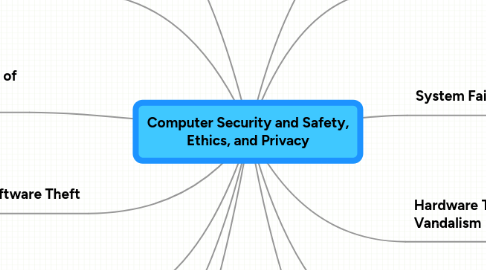Computer Security and Safety, Ethics, and Privacy
저자: sasinai phansan

1. Computer Security Risks
1.1. Hackers
1.2. Crackers
1.3. Script Kiddies
1.4. Corporate Spies
1.5. Unethical Employees
1.6. Cyberextortionists
1.7. Cyberterrorists
2. Unauthorized Access and Use
2.1. Acceptable use policy
2.2. Disable file and printer sharing
2.3. Firewalls
2.4. Intrusion detection software
3. Software Theft
3.1. Steals software media
3.2. Intentionally erases programs
3.3. Illegally copies a program
3.4. Illegally registers and/or actives a progam
4. Information Theft
4.1. Digital Certificates
4.2. Transport Layer Security (TLS)
4.3. Secure HTTP
4.4. VPN
5. Wireless Security
5.1. shouldn't broadcast an SSID
5.2. change the default SSID
5.3. Configure a WAP
5.4. use WPA or WPA2
6. Health Concerns of Computer Use
6.1. RSI
6.2. CTS
6.3. CVS
7. Summary
7.1. Potential computer risks and the safeguards
7.2. Wireless security risks and safeguards
7.3. computer-related
7.4. preventions
8. Objectives Overview
8.1. Discuss the types of devices available that project computers from system failure
9. Internet and Network Attacks
9.1. Computer Virus
9.2. Worm
9.3. Rootkit
9.4. New node
10. Hardware Theft and Vandalism
10.1. Physical access controls
10.2. Alarm systems
10.3. Cables to lock equipment
10.4. Real time location system
10.5. Passwords, possessed objects, and biometrics
11. System Failure
11.1. Aging hardware
11.2. Natural disasters
11.3. Electrical power problems
11.4. Errors in computer programs
12. Backing Up - The Ultimate Safeguard
12.1. Full backup
12.2. Selective backup
13. Ethics and Society
13.1. Allow for personalization
13.2. Store users' passwords
13.3. Assist with online shopping
13.4. Tack how often users visit a site
13.5. Target advertisements


